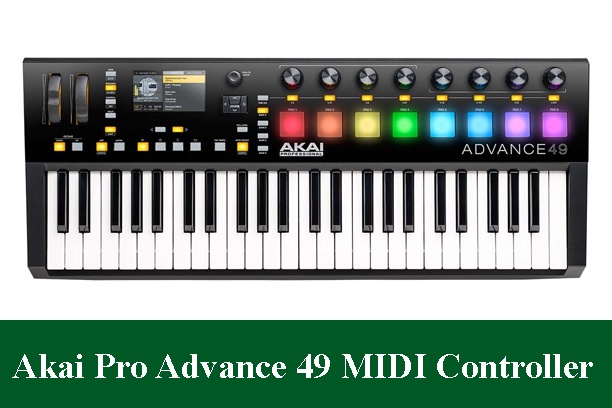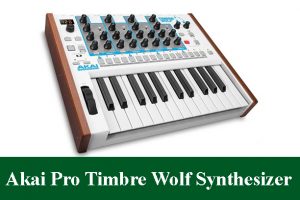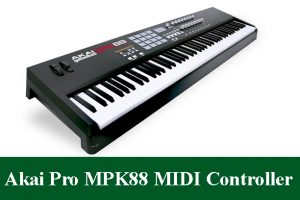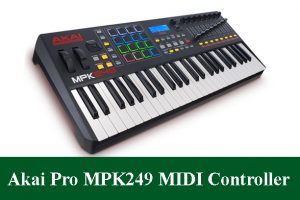Akai Professional Advance 49 Virtual Instrument Production Controller to Premium Controller for VIP Review (Updated)
In this review, I’ll be talking about the Akai Advance 49, a 49 key MIDI keyboard from Akai. Akai is famous for their music production tools, such as the MPC, a sampler and drum machine that revolutionized hip hop and music production alongside Roland’s TR-808 back in the 80s and 90s, and is still used today. Akai believes in the power of a good workflow, which means that they think you should be able to make music and perform quickly, easily, and without too many stops. However, they ask one thing in return: that you learn their machines first.
Ultimately, that message is still conveyed with the Advance 49. I’ll talk about the features in a little bit, but I wanted to mention that this MIDI keyboard will take some time to get fully comfortable with, so if you’re already accustomed to using something else, you might not like this keyboard.
I know that for me, I have a specific workflow developed that I usually do not deviate too far from, and while I can see what Akai is doing with this MIDI controller, I am not wholly on board. That being said, I was very eager to try out the Advance 49 because I wanted to see what all the fuss was about (and while I’ll save my complete thoughts and grade for later, I can already see that if you spend some time with this instrument, you’ll see an improved workflow).
Utilizing MIDI Controllers
In the present period of digital synths, keyboards, and MIDI controllers, it’s not unreasonable to anticipate innovation in the domain of music production. MIDI keyboards, in case you’re not acquainted with them, are designed to control Digital Audio Workstations (DAWs) and delicate synth modules facilitated on the PC to make sounds or recording and live execution.
It’s entirely common nowadays to record music basically through a MIDI controller and a PC only.
So I’m not catching this’ meaning for you? All things considered, in the event that you have a PC equipped for music production as of now, a MIDI keyboard can be a wonderful venture. Be that as it may, there are such a significant number of MIDI keyboards available, choosing can feel out and out overpowering.
Don’t stress that is what I’m here for, as I’ll not exclusively be examining the Advance 49 top to bottom today, yet in addition contrasting it with some commendable contenders to perceive how well the Advance 49 piles up against its adversaries.
Diagram
To start, I connected the Akai Advance 49 and connected it to my PC. The screen on the left hand side is clear, splendid, and significantly more present day than screens on past MIDI controllers. I can see now why this thing is retails at around $500: the item is worked with superb parts.
The keybed feels great as well, there are 49 keys and they are full-sized, springy, and unweighted (obviously) yet generally speaking sufficiently durable to withstand enthusiastic playing, should the need call for it.
Aftertouch is a common impact on MIDI controllers and keyboards today, however I don’t get that’s meaning, precisely? Aftertouch essentially continues to send information as you increment weight subsequent to having effectively struck a key. Along these lines, when I pulled up the Addictive Keys Plugin (a well known piano VST module) I ensured it could get MIDI information after I squeezed the key.
It worked fine, and in spite of the fact that this is an unpretentious feature, I believe it merits mentioning. Aftertouch gives the keys a somewhat increasingly reasonable “piano” feel, so it’s pleasant to realize they put it on this keybed.
Handles, Buttons, And More
The Advance 49 has a great deal of buttons and handles. On the left close to the screen are the wheels controlling pitch and mod. They felt truly pleasant, not excessively shaky, but rather the elastic covering is an intriguing surface to become acclimated to. Close to these are the octave controls, critical for any keyboard that is anything but an entire 88 keys. They respond immediately when you move all over, which is decent.
At the left focus of the keyboard confront is the confused interface. Like I said before, the screen looks incredible—it’s brilliant and the display is clear. There are a few perusing buttons encompassing the screen, some to explore through the control framework and others for activating actions like chronicle in the DAW. Most MIDI controllers have the DAW buttons, I realize mine does, so I was extremely acquainted with these. Be that as it may, the other perusing buttons, in addition to the keypad, paused for a moment to become accustomed to.
I should stop here and mention that the Akai Advance 49 accompanies a duplicate of their VIP programming. Akai likes you to utilize their product, and keeping in mind that it’s not constantly incorporated as effectively as they believe, it’s quite often ground-breaking.
VIP Software and Sounds
Fundamentally, it’s a place to have the majority of your sounds, including the ones that accompany the VIP and VST Plugins you as of now have. It’s essentially a virtual library for the majority of your synth sounds. To put it plainly, you utilize the parchment haggle keys to explore through your sounds and at last select one by squeezing enter.
In any case, there’s considerably more you can do. You can alter sounds by doling out controllable channels to the handles on the correct side of the keyboard that you can change to your loving. You utilize the program button to get to your preferred module and look through pages of presets and tap on ones that sound intriguing. The move button is utilized to control distinctive actions when utilizing the parchment wheel.
I don’t care for this feature, and I believe it’s more confused than utilizing your mouse or PC track cushion to physically alter sounds on your PC’s screen. Be that as it may, I assume on the off chance that you took the time and learned it front to back, you’d get snappy at it.
You can likewise press the multi-button to layer sounds from any module you need over your unique sound. I do like this feature, which makes layering simpler than equipping numerous tracks in a DAW, and I would see myself utilizing this.
So as should be obvious, I have a blended opinion with regards to the common sense of this interface; is every last bit of it essential or is it pointlessly improved? It’s unquestionably difficult to state. On the off chance that you need to peruse progressively about VIP programming and how to set it up with the Advance 49, look at the client direct that broadly expounds on the most proficient method to incorporate it.
The Pads of Akai Advance 49
If you like assigning sounds, notes, samples, etc. to pads, then you’ll love the pad feature. The pads feel great, they’re very sensitive, and while there are only eight of them, you get four banks to cycle through so you can use up to 32 pads on each setting.
The knobs feel great too; they spin forever and they are easy to spin and grab. Both the pads and knobs are large, which I think would make it easier if you’re playing the keyboard on a stage and need to make a quick change.
The Advance 49 has an onboard arpeggiator with several different rate options (as highlighted by the buttons between the pads and knobs) and a latch button which locks the arp in place, so it keeps going when you let go of the keys. I’ve always loved Akai’s arpeggiators. I think they’re practical, easy to use, and I always find myself wishing every MIDI controller had one. There’s also a tempo tap, which is always useful, especially if you’re importing a sample that needs a different tempo.
Aesthetically, I don’t have any complaints. In fact it actually looks really good. It has red sides, a sturdy rectangular plastic frame, and the side where the inputs and outputs are looks both professional and modern. The Advance 49 weighs just under ten pounds, and I think that’s a perfect weight because it isn’t flimsy while remaining portable.
As for the inputs and outputs, the Advance 49 has you covered. It has an option for the 5-pin MIDI if you need it, otherwise you can just use the USB port, which is definitely easier. It has external power if you need it, and there is also a sustain and expression pedal option, which is great for live performance.
Featured Details of Akai Advance 49
- Coordinated 4.3-inch high-resolution full-shading screen with devoted interface buttons.
- Screen gives 1:1, continuous input of module parameters.
- Incorporates Virtual Instrument Player (VIP) programming for remarkable virtual instrument preset administration, control mapping and multi fix creation.
- 49 premium, semi-weighted speed touchy keybed with aftertouch.
- 8 extensive, perpetual and continuously factor control handles + 4 banks.
Conclusion
With regards to picking a 49 key midi keyboard controller, it’s occasionally difficult to pick the correct brand and model. Akai is truly adept at doing its very own thing, and for devotees of Akai, this is extraordinary. The issue is that individuals who aren’t personally acquainted with Akai’s interfaces will battle, at any rate at first.
There are some cool components on this keyboard. It feels great generally speaking, and it really looks extraordinary. I simply don’t see myself regularly needing to utilize their interface or their VIP programming. It appears as though my money would be best spent somewhere else, and you can tell a larger part of the cost of the Advance 49 goes toward subsidizing their work process components.
I don’t have any desire to dishearten you, since this is only my opinion, and I’m certain many individuals love this keyboard, however for me, I need something somewhat less demanding to utilize.





